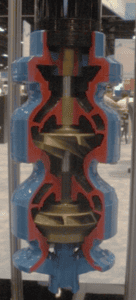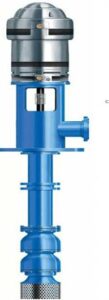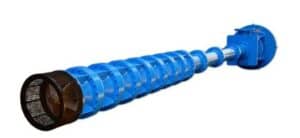Electric Motor VTP Vertical Turbine Pump
What is an electric motor VTP vertical turbine pump?
An electric motor VTP vertical turbine pump is a centrifugal pump specially designed to transport water from deep underground wells or reservoirs using several turbine-like impellers enclosed in a bowl. Contrary to what its name might imply, this pump has nothing to do with a turbine. Instead, it uses an AC induction motor located at the surface and connected via a long vertical shaft to impellers at the bottom of the pump. The electric motor VTP vertical turbine pump manufacturers develop the device to be fully submerged in the pumped fluid and for use in place of a submersible Pump in many applications, typically where the required flow is higher than a submersible pump can deliver. Comparatively, the electric motor VTP vertical turbine pump is more practical than a similar submersible pump because the electric motor at the surface is kept dry and free of any potential risks. Generally, electric motor VTP vertical turbine pumps suit clean water applications that require high pressure and high head.

Figure: electric VTP vertical turbine pump
Components of electric motor VTP vertical turbine pump
Motor
The electric motor VTP vertical turbine pump utilizes an AC induction motor located above the ground. The purpose of the electric motor is to provide rotational power for the pump. The AC induction motor employs the principle of electromagnetic induction to generate the mechanical torque needed to run the rotor. It may contain either fixed or variable-speed drives.
Pump casing
The electric motor VTP vertical turbine pump employs a diffusing type of casing. The pump casing is a thin air- passage surrounding the impeller. It functions as a pressure containment vessel and directs fluid flow in and out of the pump. The vertical VTP turbine pump manufacturers create the casing from cast iron, carbon steel, or stainless steel to enhance strength, corrosion durability, and abrasion resistance.
Bowl assembly
The electric motor VTP vertical turbine pump’s bowl assembly consists of the suction port, shaft, impellers, and diffusing-style casing. Each diffuser comprises one impeller, and together they make a pump stage.
Figure: Showing the bowl assembly.
Shaft
The vertical turbine pump’s shaft is a long cylindrical piece of metal centrally located in the pump and supported on bearings. It carries the impellers and connects the motor to the pump head through a flexible coupling. The pump shaft is usually grounded and polished to provide a smooth bearing surface. It is also designed to provide maximum strength and excellent corrosion resistance using high-end materials such as stainless steel, alloy steel, carbon steel, etc.
Impeller
In an electric motor VTP vertical turbine pump, the impeller is shaped like a turbine with radially oriented teeth to displace water. The impeller is a rapidly rotating fan with blades attached to the pump shaft. It directs water into a diffuser casing called a bowl by increasing the kinetic energy and velocity of the water. Electric motor VTP vertical turbine pump manufacturers tailor the impeller to provide a wide range of hydraulic coverage and maximum efficiency.
Coupling
The electric motor VTP vertical turbine pumps use a flexible coupling, allowing for easier servicing of thrust bearings and mechanical seals. The coupling connects the pump shaft to the motor shaft facilitating the transfer of torque and rotation of the impellers. The coupling is precision machined and balanced for perfect alignment and power transmission.
Suction inlet
An electric motor VTP vertical turbine pump’s suction inlet is created with a hydrodynamic design to ensure a smooth liquid flow at the entrance. The suction inlet allows the entry of water into the pump. It also contains an oversized inlet strainer that prevents solids from entering the hydraulic assembly.
Discharge outlet
The water exits the pump through the discharge outlet. The electric motor VTP vertical turbine pump’s discharge outlet has a low-loss design and can be fabricated from ductile iron or cast using cast steel.
How does an electric motor VTP vertical turbine pump work?
An electric motor vertical VTP turbine pump pushes water from a well to the ground surface by converting the mechanical of an impeller into kinetic and pressure energy of the pumped liquid. When the motor starts, the impellers rotate, creating a vacuum inside the pump casing. As a result, the water enters the first chamber through the suction bell due to the atmospheric pressure acting on the water’s surface. Once the water strikes the first stage impeller, the centrifugal force acting on its blades imparts high velocity and kinetic energy to the liquid. The water then flows into a bowl directly above the impeller, where the high-velocity energy is converted into high pressure. The bowl then directs the water into the second stage impeller, where fluid pressure further increases. This process continues through all stages of the pump leading to a progressive increase in water pressure. After the water leaves the final pump stage, it discharges into a vertical column pipe, which rises from the well to the ground surface.
Figure: Working of an electric motor VTP vertical turbine pump.
Double-stage electric motor VTP vertical turbine pump
A double-stage electric motor VTP vertical turbine pump has two impellers housed in separate diffusing pump chambers but mounted onto a single bowl shaft that passes through the middle of the diffusers. This pump provides the functionality of two pumps linked in a series.
Figure: Double-stage electric motor VTP vertical turbine pump.
Multistage electric motor VTP vertical turbine pump
A multistage electric motor VTP vertical turbine pump consists of more than two impellers housed in different pump chambers that are mounted in series. Water enters the first chamber at suction pressure, and as it passes through consecutive pumping stages, the water pressure increases progressively. This pump can manage higher pump head and flow rates than the double-stage counterpart and can work with a smaller motor.
Figure: Multistage electric motor VTP vertical turbine pump.
Applications of electric motor VTP vertical turbine pump
Electric motor VTP vertical pumps suit various agricultural, municipal, and industrial applications. They are evident in irrigation farmlands, water treatment plants, municipal water systems, etc. Typical uses of these pumps include the following:
- Electric motor VTP vertical pumps pump water out of deep pits or wells.
- Water municipalities that rely on groundwater rather than surface water also use the electric motor VTP vertical turbine pump because they can provide high water volume from an underground source.
- Electric motor VTP vertical pumps are used in wells that provide irrigation water to agriculture.
- They are also used as booster pumps to increase water pressure for applications requiring water supply at extreme pressure.
- They are also used in open bodies of water to move water for various purposes. Often, they will be used with tanks for industrial applications.
- They are used in firefighting applications.
Advantages of an electric motor VTP vertical turbine pump
- Electric motor VTP vertical turbine pumps have a small footprint.
- They are perfect for the supply of clean water at high pressure and low flow rate.
- They are free of priming issues because the impeller is submerged in water.
- They are highly efficient on the high head, low-flow applications.
- Electric motor VTP vertical turbine pumps have high versatility. They can generate flow from 50 to 30,000 gallons per minute (GPM) or higher. In addition, they can be configured with multiple stages to raise the required pressure for an application.
- They have a low life cycle due to minimal maintenance requirements.
- The pump’s motor sits on the ground; thus, it is easier to repair the motor without disturbing the pump assembly.
- They have compact construction with small impellers because the head per stage is less.
- They provide a stable performance.
Disadvantages of an electric motor VTP vertical turbine pump
- Electric motor VTP vertical turbine pump cannot handle fluid with entrained or dissolved gases because the gas accumulates in the sealed chamber, where venting is complicated.
- The initial acquisition and installation cost of the pump is relatively high.
- It is not easy to balance hydraulic thrust on vertical turbine pumps because of their overhang shaft.
- They also require a large amount of headroom for installation.
Troubleshooting electric motor VTP vertical turbine pump
The electric motor is overheating
- The motor is poorly installed. Ensure the pump is installed to the electric motor VTP vertical turbine pump manufacturer’s standards.
- The motor is defective. Inspect and replace the prime mover if it is necessary.
- Poor coupling alignment. Be sure to realign the pump and coupling. Also, check the coupling rubber for wear.
- The electric motor VTP vertical turbine pump is working cavitation. Check that the pump works within the correct speed range and uses the right impeller type.
The pump fails to start
- There is a blown-out fuse or tripped circuit breaker. Inspect the electric VTP vertical turbine pump for a blown-out fuse and replace it if necessary.
- The voltage is irregular due to dirt or corrosion at the pressure switch. Inspect the pressure switch and clean it of any debris or pollution.
- The fuse receptacles are dirty or corroded. Inspect and clean fuse receptacles if necessary.
- The power supply to the panel is insufficient. Ensure that the motor receives the right amount of voltage and current.
The pump has low capacity
- The pump is operating in reverse. Check that the direction of the motor rotation matches the direction indicated by the electric VTP vertical turbine pump manufacturers on the nameplate. Be sure to reverse the motor polarities.
- The pump is air bound. Ensure that the pump system is free of air.
- The check valve has failed or is wrongly installed. Inspect the check valve, install it correctly, or replace it.
- Clogged impeller. Inspect the impeller and remove any material.
There is excessive pump vibration
- There are unbalanced components in the electric motor VTP vertical turbine pump. Inspect and rebalance the elements.
- Oblique or unbalanced shaft. Inspect the pump’s shaft and rebalance it as needed.
- The pump assembly is loose. Tighten pump components to the torque level recommended by the electric VTP vertical turbine manufacturers.
- The impellers are severely worn-out or defective. Inspect the impellers and replace any worn-out impeller with another one from the pump manufacturer if necessary.
- The pump grease is excessive or contaminated. Drain the excess oil or bearings and housing.
- There is an airlock in the pump. Loosen the vent plug to purge air.
The pump provides an unstable flow
- There is a leakage in the bottom valve. Inspect the bottom valve for leakage and correct it.
- The voltage is too low, causing a decrease in pump speed. Check the power supply voltage and adjust it as necessary.
- Severe wear of impeller or seal ring. Inspect and replace worn-out impeller or seal ring.
Summary
An electric motor VTP vertical turbine pump is a highly engineered type of centrifugal pump for transporting water from deep underground wells or reservoirs to some water distribution systems. It features several turbine-like impellers enclosed in a diffuser casing called a bowl to displace water through the pump. However, unlike the pump’s name may seem to imply it has nothing to do with a turbine. Instead, it uses an AC induction motor located at the ground surface and connected via a long vertical shaft to impellers at the bottom of the pump. The electric motor VTP vertical turbine pump manufacturers develop the pumps to fully submerge into the pumped fluid. They are usually employed in place of submersible pumps in applications requiring lower flow and high head than submersible pumps can provide. Electric motor VTP vertical pumps suit clean water supply for agricultural, municipal, and industrial uses. They are versatile, highly efficient, and have a compact construction with small impellers because the head per stage is less.




